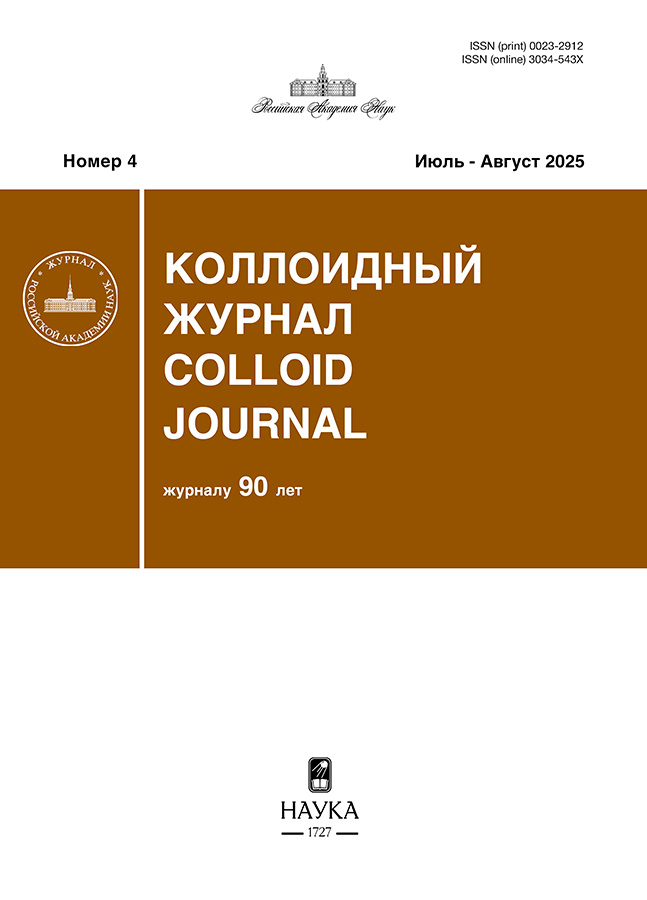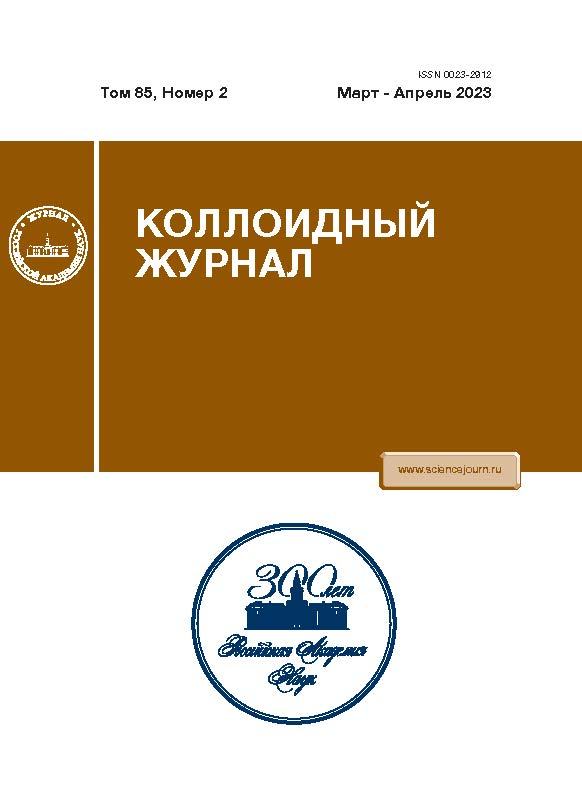Микроэмульсии лецитина с маслом гака и эфирным маслом куркумы
- Авторы: Мурашова Н.М.1, Нгуен Х.Т.1
-
Учреждения:
- Российский химико-технологический университет имени Д.И. Менделеева
- Выпуск: Том 85, № 2 (2023)
- Страницы: 191-199
- Раздел: Статьи
- Статья получена: 27.02.2025
- Статья опубликована: 01.03.2023
- URL: https://genescells.com/0023-2912/article/view/671663
- DOI: https://doi.org/10.31857/S0023291223600049
- EDN: https://elibrary.ru/UUWDCO
- ID: 671663
Цитировать
Полный текст
Аннотация
Показано, что для получения обратных микроэмульсий в системах лецитин–олеиновая кислота–вазелиновое масло–растительное масло–эфирное масло–вода можно использовать масло из тропического растения гака (Momordica cochinchinensis) и эфирное масло куркумы (Curcuma longa). В микроэмульсию можно ввести не менее 6.5 мас. % воды при концентрации лецитина в органической фазе 20 мас. %, соотношении вазелинового масла и масла гака 1 : 1 по массе и при мольном соотношении олеиновой кислоты и лецитина от 0.2 до 0.8. Гидродинамический диаметр капель микроэмульсий составлял, в зависимости от содержания воды и лецитина, от 3 до 21 нм. Методом ИК-Фурье спектроскопии показано, что для микроэмульсии с W = 14 доля объемной (свободной) воды в каплях составила 36.5 мол. %, доля гидратной (связанной с полярными группами ПАВ) воды – 55.0 мол. %, доля воды, находящейся среди углеводородных цепей – 8.5 мол. %. Методом диализа на модели водорастворимого красителя Родамина С показано, что скорость его переноса из микроэмульсии в физиологический раствор составила 15.4 × 10–3 г/(м2 ч); за 6 часов выделилось примерно 3.2% красителя, что позволяет разрабатывать препараты с замедленным высвобождением лекарственных веществ.
Об авторах
Н. М. Мурашова
Российский химико-технологический университет имени Д.И. Менделеева
Email: namur_home@mail.ru
Россия, 125047, Москва,
Миусская пл., 9
Х. Т. Нгуен
Российский химико-технологический университет имени Д.И. Менделеева
Автор, ответственный за переписку.
Email: namur_home@mail.ru
Россия, 125047, Москва,
Миусская пл., 9
Список литературы
- Fanun M. Microemulsions as delivery systems // Current Opinion in Colloid and Interface Science. 2012. V. 17. № 5. P. 306–313. https://doi.org/10.1016/j.cocis.2012.06.001
- Lawrence M.J., Rees G.D. Microemulsion-based media as novel drug delivery systems // Advanced Drug Delivery Reviews. 2012. V. 64. P. 175–193. https://doi.org/10.1016/j.addr.2012.09.018
- Callender S.P., Mathews J.A., Kobernyk K., Wettig S.D. Microemulsion utility in pharmaceuticals: implications for multi-drug delivery // International Journal of Pharmaceutics. 2017. V. 526. № 1–2. P. 425–442. https://doi.org/10.1016/j.ijpharm.2017.05.005
- Shukla T., Upmanyu N., Agrawal M. et al. Biomedical applications of microemulsion through dermal and transdermal route // Biomedicine & Pharmacotherapy. 2018. V. 108. P. 1477–1494. https://doi.org/10.1016/j.biopha.2018.10.021
- Szumała P., Macierzanka A. Topical delivery of pharmaceutical and cosmetic macromolecules using microemulsion systems // International Journal of Pharmaceutics. 2022. V. 615. P. 121488. https://doi.org/10.1016/j.ijpharm.2022.121488
- Angelico R., Ceglie A., Colafemmina G. et al. Phase behavior of the lecithin/water/isooctane and lecithin/water/decane systems // Langmuir. 2004. V. 20. № 3. P. 619–631. https://doi.org/10.1021/la035603d
- Мурашова Н.М., Юртов Е.В. Лецитиновые органогели как перспективные функциональные наноматериалы // Российские нанотехнологии. 2015. Т. 10. № 7– 8. С. 5–14.
- Shinoda K., Araki M., Sadaghiani A. et al. Lecithin-based microemulsions: phase behavior and microstructure // Journal of Physical Chemistry. 1991. V. 95. № 2. P. 989–993.
- Aboofazeli R., Lawrence C.B., Wicks S.R., Lawrence M.J. Investigations into the formation and characterization of phospholipid microemulsions. III. Pseudo-ternary phase diagrams of systems containing water-lecithin-isopropyl myristate and either an alkanoic acid, amine, alkanediol, polyethylene glycol alkyl ester or alcohol as cosurfactant // International Journal of Pharmaceutics. 1994. V. 111. № 1. P. 63–72. https://doi.org/10.1016/0378-5173(94)90402-2
- Aboofazeli R., Patel N., Thomas M., Lawrence M.J. Investigations into the formation and characterization of phospholipid microemulsions. IV. Pseudo-ternary phase diagrams of systems containing water-lecithin-alcohol and oil: the influence of oil // International Journal of Pharmaceutics. 1995. V. 125. № 1. P. 107–116. https://doi.org/10.1016/0378-5173(95)00125-3
- Xu M., Yu Q., Zhao Q. et al. Development and in vitro-in vivo evaluation of water-in-oil microemulsion formulation for the oral delivery of troxerutin // Drug Development and Industrial Pharmacy. 2016. V. 42. № 2. P. 280–287. https://doi.org/10.3109/03639045.2015.1047849
- Brime B., Moreno M.A., Frutos G. et al. Amphotericin B in oil-water lecithin-based microemulsions: formulations and toxicity evaluation // Journal of Pharmaceutical Sciences. 2002. V. 91. № 4. P. 1178–1185. https://doi.org/10.1002/jps.10065
- Moreno M.A., Ballesteros M.P., Frutos P. Lecithin-based oil-in-water microemulsions for parenteral use; pseudoternary phase diagrams, characterization and toxicity studies // Journal of Pharmaceutical Sciences. 2003. V. 92. № 7. P. 1428–1437. https://doi.org/10.1002/jps.10412
- Murashova N.M., Prokopova L.A., Trofimova E.S., Yurtov E.V. Effects of oleic acid and phospholipids on the formation of lecithin organogel and microemulsion // Journal of Surfactants and Detergents. 2018. V. 21. № 5. P. 635–645. https://doi.org/10.1002/jsde.12170
- Changez M., Varshney M., Chander J., Dinda A.M. Effect of the composition of lecithin/n-propanol/isopropyl myristate/water microemulsions on barrier properties of mice skin for transdermal permeation of tetracaine hydrochloride: in vitro // Colloids and Surfaces B: Biointerfaces. 2006. V. 50. № 1. P. 18–25. https://doi.org/10.1016/j.colsurfb.2006.03.018
- Changez M., Chander J., Dinda A.M. Transdermal permeation of tetracaine hydrochloride by lecithin microemulsion: in vivo // Colloids and Surfaces B: Biointerfaces. 2006. V. 48. № 1. P. 58–66. https://doi.org/10.1016/j.colsurfb.2006.01.007
- Yuan J.S., Ansari M., Samaan M., Acosta E.M. Linker-based lecithin microemulsions for transdermal delivery of lidocaine // International Journal of Pharmaceutics. 2008. V. 349. № 1–2. P. 130–143. https://doi.org/10.1016/j.ijpharm.2007.07.047
- Paolino D., Ventura C.A., Nistico S. et al. Lecithin microemulsions for the topical administration of ketoprofen: percutaneous adsorption through human skin and in vivo human skin tolerability // International Journal of Pharmaceutics. 2002. V. 244. № 1–2. P. 21–31.
- Savic V., Todosijevic M., Ilic T. et al. Tacrolimus loaded biocompatible lecithin-based microemulsions with improved skin penetration: Structure characterization and in vitro/in vivo performances // International Journal of Pharmaceutics. 2017. V. 529. № 1–2. P. 491–505. https://doi.org/10.1016/j.ijpharm.2017.07.036
- Lin C.-C., Lin H.-Y., Chi M.-H. et al. Preparation of curcumin microemulsions with food-grade soybean oil/lecithin and their cytotoxicity on the HepG2 cell line // Food Chemistry. 2014. V. 154. P. 282–290. https://doi.org/10.1016/j.foodchem.2014.01.012
- Pestana K.C., Formariz T.P., Franzini C.M. et al. Oil-in-water lecithin-based microemulsions as a potential delivery system for amphotericin B // Colloids and Surfaces B: Biointerfaces. 2008. V. 66. № 2. P. 253–259. https://doi.org/10.1016/j.colsurfb.2008.06.016
- Мурашова Н.М., Трофимова Е.С., Костюченко М.Ю. и др. Микроэмульсии и лиотропные жидкие кристаллы лецитина как системы для трансдермальной доставки лекарственных веществ // Российские нанотехнологии. 2019. Т. 14. № 1–2. С. 69–75.
- Basov A., Fedulova L., Vasilevskaya E. et al. Sus Scrofa immune tissues as a new source of bioactive substances for skin wound healing // Saudi Journal of Biological Sciences. 2021. V. 28. № 3. P. 1826–1834. https://doi.org/10.1016/j.sjbs.2020.12.028
- Do T.V.T., Fan L., Suhartini W., Girmatsion M. Gac (Momordica cochinchinensis Spreng) fruit: A functional food and medicinal resource // Journal of Functional Foods. 2019. V. 62. P. 103512. https://doi.org/10.1016/j.jff.2019.103512
- Mai H.C., Debaste F. Gac (Momordica cochinchinensis (Lour) Spreng.) oil // Fruit Oils: Chemistry and Functionality. Edt. Ramadan M.F. Springer Nature Switzerland AG, 2019. P. 377–395. https://doi.org/10.1007/978-3-030-12473-1_18
- Abdulqader A., Ali F., Ismail A., Esa N.M. Gac (Momordica cochinchinensis Spreng.) fruit and its potentiality and superiority in health benefits // Journal of Contemporary Medical Science. 2018. V. 4. №. 4. P. 179–186. https://doi.org/10.22317/jcms.v4i4.476
- Chuyen H.V., Nguyen M.H., Roach P.D. et al. Gac fruit (Momordica cochinchinensis Spreng.): a rich source of bioactive compounds and its potential health benefits // International Journal of Food Science and Technology. 2015. V. 50. P. 567–577. https://doi.org/10.1111/ijfs.12721
- Ivanović M., Makoter K., Razboršek M.I. Comparative study of chemical composition and antioxidant activity of essential oils and crude extracts of four characteristic zingiberaceae herbs // Plants. 2021. V. 10. № 3. P. 501. https://doi.org/10.3390/ plants10030501
- Amiri-Rigi A., Abbasi S. Extraction of lycopene using a lecithin-based olive oil microemulsion // Food Chemistry. 2019. V. 272. P. 568–573. https://doi.org/10.1016/j.foodchem.2018.08.080
- Jalali-Jivan M., Abbasi S. Novel approach for lutein extraction: food grade microemulsion containing soy lecithin and sunflower oil // Innovative Food Science and Emerging Technologies. 2020. V. 66. P. 102505. https://doi.org/10.1016/j.ifset.2020.102505
- Мурашова Н.М., Полякова А.С., Юртов Е.В. Влияние ди-(2-этилгексил)фосфорной кислоты на свойства микроэмульсии в системе ди-(2-этилгексил)фосфат натрия–ди-(2-этилгексил)фосфорная кислота–декан–вода // Коллоид. журн. 2018. Т. 80. № 5. С. 541–550.
- Valero M., Sanchez F., Gomez-Herrera C., Lopez-Cornejo P. Study of water solubilized in AOT/n-decane/water microemulsions // Chemical Physics. 2008. V. 345. P. 65–72. https://doi.org/10.1016/j.chemphys.2008.01.048
Дополнительные файлы
















